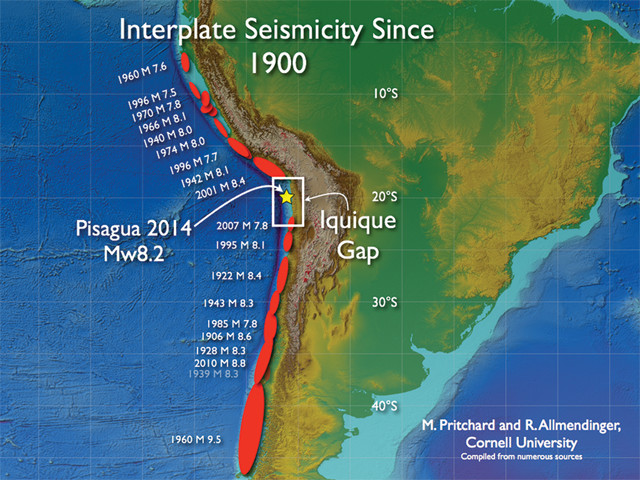
by Julia Rosen Monday, March 9, 2015

Since 1900, many large earthquakes have occurred along the boundary where the Nazca Plate subducts below the South American Plate. Credit: Matthew Pritchard and Richard Allmendinger, Cornell University.
On April 1, 2014, a magnitude-8.2 earthquake shook the empty stretch of coast where Chile arcs into Peru, a region called the Iquique Gap. The gap is the only part of the 7,000 kilometer-long boundary between the Nazca and South American plates that hadn’t ruptured in the past century, despite a collision rate of almost 65 millimeters per year.
Now, it appears that a small tremor on a nearby shallow fault may have triggered the quake, researchers say. Such a phenomenon hasn’t been clearly documented before, and it could force geologists to rethink earthquake hazards in Chile and beyond.
“We usually think of subduction events triggering earthquakes in the upper plate,” says Richard Allmendinger, the Cornell University geologist who proposed the new idea at the Geological Society of America’s annual meeting in Vancouver, British Columbia, last October. But in the case of the 2014 Pisagua (or Iquique) earthquake, it may have worked the other way around.
The clue that tipped off Allmendinger’s team was that the first major foreshock, a magnitude-6.7 temblor on March 16, broke along a plane perpendicular to the coastline and the plate boundary — a “curious” occurrence, Allmendinger says. He and his students had spent the last decade studying east-west trending faults that form in the curved section of the Chilean margin, and he says he wondered if one of these had ruptured.
After several groups pinpointed the quake’s location, confirming Allmendinger’s suspicions, he and his colleagues modeled how the relatively modest magnitude-6.7 foreshock would have changed the stress on the surrounding faults. They found that it may have initiated a chain reaction of ruptures, including six magnitude-5 and -6 events that marched north along the plate boundary and deeper into the subduction zone. Finally, 36 kilometers from the site of the March 16 event, something tipped the plate boundary over a threshold, resulting in the April 1 Pisagua earthquake.
However, not everyone is convinced that the foreshocks actually caused the main shock. The events may be related, but “one could imagine other possibilities” for why the fault broke, says Bernd Schurr, a seismologist at the German Research Center for Geosciences in Potsdam who has studied the Pisagua earthquake extensively. For instance, instead of stress unclamping the fault, fluids rising from the slab could have weakened the interface, he says. Allmendinger says both processes may have played a role.
However, neither Allmendinger nor Schurr can explain perhaps the most vexing aspect of the Pisagua earthquake: although formidable, it failed to release much of the strain built up along large segments of the Iquique Gap. “Unfortunately for the residents of northern Chile, there are probably still great things to come from the rest of the gap,” Allmendinger says. “The big question that no one knows the answer to is whether the gap will rupture in a single great event,” he says, or whether the strain will be released “by smaller Pisagua-style ruptures.”
If validated, this new mechanism has implications beyond the Chilean margin — the Pacific Northwest also has a curved subduction zone that could experience a similar phenomenon. Ray Wells, a geologist with the U.S. Geological Survey in Menlo Park, Calif., says there are numerous east-west faults in the Cascadia Subduction Zone (CSZ) that share similarities with the one that ruptured prior to the Pisagua event.
One of the largest is the Seattle Fault, which runs beneath its eponymous city and poses a more direct hazard to its residents than the CSZ, Wells says, although it ruptures less often. So far, he says, there’s no evidence in the geologic record that earthquakes along shallow faults in Cascadia correspond to major subduction zone events, but that doesn’t mean it couldn’t have happened.
Without question, Wells says, people would pay attention to any earthquake in the Cascadia region. “If there should be a magnitude-6-plus [quake] offshore” — like the one that happened in Chile — “you can bet everyone would be very interested and concerned about what would happen next,” he says. The results from Allmendinger’s team suggest such an event could be the prelude to something more.
© 2008-2021. All rights reserved. Any copying, redistribution or retransmission of any of the contents of this service without the expressed written permission of the American Geosciences Institute is expressly prohibited. Click here for all copyright requests.